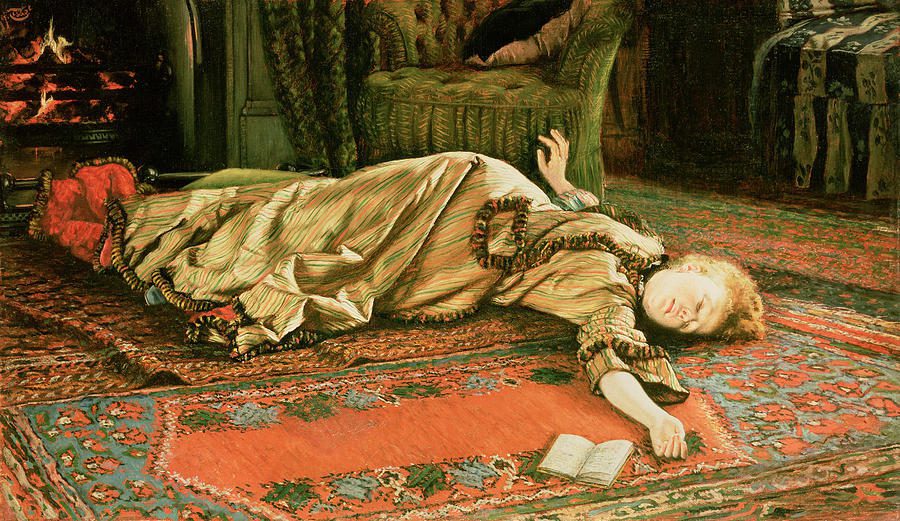Howard Fischer
Uppsala, Sweden
 |
| Abandoned. Painting by James Tissot, c.1881–2. Via Bridgeman Images on Fine Art America. Public domain. |
“Fall backward if you faint, and not across the patient.”1
– Surgeon Sir Lancelot Sprat, in the film Doctor in the House
The squeamishness of the beginning medical student or intern during the dissection of a cadaver or in the operating room has become a cinematic cliché. In the films Not as a Stranger (1955) and Mary Shelley’s Frankenstein (1994), a student faints as the demonstrator makes the first incision in a cadaver. In Doctor in the House (1954), a student faints at the start of an operation.2
Fainting, or syncope, is a transient, sudden loss of consciousness due to reduced cerebral blood flow. The most common cause is vasovagal syncope, also called the “common faint,” or “church faint.” Fright, emotional upset, and overheating may cause fainting. These triggers cause peripheral venous pooling and decreased venous return to the heart. A reflex mechanism then produces a vagal response that includes bradycardia (a slow heart rate) and hypotension. Presyncopal symptoms include lightheadedness, anxiety, feeling warm, and narrowing of the visual fields, or “tunnel vision.” This is followed by a loss of consciousness and falling to the ground (syncope), where cerebral circulation returns to normal and consciousness returns within seconds to a minute or two.3
The incidence of fainting in the operating room or dissection room has been studied. In a study of first- to fourth- (final) year medical students in Canada, 42% of 180 students experienced presyncope in the operating room, and 6% had actual syncope.4 In a study of 630 fourth- and fifth- (final) year students in the UK, 12% experienced syncope or near-syncope in the operating room.5 A study of third- to fifth- year medical students in Pakistan showed that 56 of 170 students—about 33%—fainted or nearly fainted in the operating room.6 Women were the majority of those who fainted in these three operating room studies. In the Canadian and UK studies, some of the fainting students became discouraged about choosing surgery as their potential career path.7,8 Fainting on seeing a dissection occurred in 1% of 205 students in Oman,9 6% of 145 students in Jordan,10 and 7% of about 211 second-year medical students in Ethiopia.11
These studies indicate that fainting in medical students is not rare. It should be noted that the studies excluded individuals with a history of previous fainting episodes. Experienced physicians, when in a “confessing” mood, sometimes reveal their personal histories of medically-related fainting without (much) embarrassment.12
Medical students should be advised about techniques that may help to prevent fainting, such as keeping well hydrated, having a small meal before visiting the operating room (to prevent hypoglycemia from contributing to the problem), and not dressing too warmly.13 A sweater is usually not needed in the operating room. They also should not stand perfectly still, since movement of the legs will increase venous return to the heart and prevent the vasovagal reflex from happening.
References
- Peter Dans. Doctors in the Movies: Boil the Water and Just Say Aah. Bloomington, IL: Medi-Ed Press, 2000.
- Dans, Boil the Water.
- Prema Ramaswamy. “Syncope.” In: McInerny et al, eds. Textbook of Pediatric Care. Elk Grove Village, IL: American Academy of Pediatrics Publications, 2009.
- Alexander Morzycki et al. “Medical student presyncope and syncope in the operating room: A mixed methods analysis.” J Surg Educ, 73(6), 2016.
- Aimun Jamjoom et al. “Operating theatre related syncope in medical students: A cross sectional study.” BMC Medical Education, 9, 2009.
- Madeeha Hassan et al. “Fainting episodes in operation theatre: A detrimental effect on surgical career choice.” Rawal Medical Journal, 43(2), 2018.
- Morzycki, “Medical student.”
- Jamjoom, “Operating theatre.”
- Marwan Abu-Hijleh et al. “Attitudes and reactions of Arab medical students to the dissecting room.” Clinical Anatomy, 10(4), 1997.
- Ziad Betaineh et al. “Attitudes and reactions of Jordanian medical students to the dissecting room.” Radiol Anat, 28, 2006.
- Dereje Getachew. “Reaction of medical students to experiences in dissection room.” Ethiop J Health Sci, 24(4), 2014.
- Howard Fischer. “Early lessons.” Hektoen International Personal Narratives, Spring 2021.
- Morzycki, “Medical student.”
HOWARD FISCHER, M.D., was a professor of pediatrics at Wayne State University School of Medicine, Detroit, Michigan.

Leave a Reply